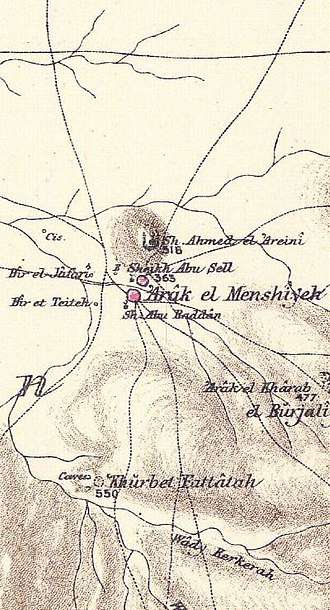Tel Erani
Coordinates: 31°36′42″N 34°47′07″E / 31.611582°N 34.785324°E Tel Erani (Hebrew) or Tell esh-Sheikh Ahmed el-ʿAreini (Arabic) is a multi-period archaeological site on the outskirts of Kiryat Gat in the Southern District of Israel. The tell was first occupied in the Chalcolithic period, but its most notable remains are from the Bronze Age and Iron Age, when it was the site of a substantial Philistine city with links to Egypt. It has been identified with the biblical cities of Libnah, Gath, Mmst, Eglon and Makkedah, but none of these identifications are certain. The city was destroyed in the 6th century BCE, possibly by the Babylonians. In the Persian period, it was the site of a temple. There are also signs of settlement in the Hellenistic, Byzantine, and Mamluk periods. The Palestinian village of Iraq al-Manshiyya was located at the foot of the tell until it was depopulated in the 1948 Arab–Israeli War.[1]
Discovery and history of investigations

Tel Erani was first documented by Claude Reignier Conder and Herbert Kitchener in their 1872–1877 survey for the Palestine Exploration Fund. They described the contemporary village of Iraq al-Manshiyya and remarked that the site was "evidently ancient and important, and seems possibly to represent the ancient Libnah." The identification of Tel Erani with the biblical city of Libnah was based on the chalk in the hills nearby – the name of the city meaning 'the white' in ancient Hebrew.[2] In 1921, William F. Albright argued that the site was a poor fit with Libnah, and instead proposed it was the major Philistine city of Gath. He placed Libnah at Tell es-Safi, which most scholars of the time identified with Gath.[3] When the Palestinian population was forced out of the area in the 1948 Arab–Israeli War, Albright's theory was the basis for naming the new Israeli settlements of Kiryat Gat and Kibbutz Gat.
In the late 1950s, Shmuel Yeivin opened excavations at the site (then known as Tel Gat) to confirm Albright's identification. Although he did find Iron Age material, the pottery was not consistent with a Philistine city. Albright's theory was therefore rejected.[1][4][5] Instead, Yeivin discovered that the main phase of occupation of the site was earlier, in the Early Bronze Age. He also found what was then the earliest evidence of contact between Egypt and Canaan: a potsherd bearing the serekh of the pharaoh Narmer.[6][5]
See also
References
- 1 2 Negev, Avraham; Gibson, Shimon (2001). "Erani (Tel)". Archaeological Encyclopedia of the Holy Land (Revised ed.). New York, NY: Continuum. pp. 166–167. ISBN 9780826485717.
- ↑ Conder, Claude Reignier; Kitchener, Horatio Herbert; Palmer, Edward Henry; Besant, Walter (1881). The Survey of Western Palestine: memoirs of the topography, orography, hydrography, and archaeology. III. London: Committee of the Palestine Exploration Fund. p. 259.
- ↑ Albright, William F. (1921). "Contributions to the Historical Geography of Palestine". The Annual of the American School of Oriental Research in Jerusalem. 2/3: 1–46. doi:10.2307/3768450. JSTOR 3768450.
- ↑ Kempinski, Aharon; Gilead, Isaac (1991). "New Excavations at Tel Erani: A Preliminary Report of the 1985–1988 Seasons". Tel Aviv. 18 (2): 164–191. doi:10.1179/tav.1991.1991.2.164. ISSN 0334-4355.
- 1 2 Czarnowicz, Marcin; Pasternak, Martin; Ochał-Czarnowicz, Agnieszka; Skłucki, Jakub (2014). "The Egyptian Presence at Tel Erani". In Jucha, Mariusz A.; Dębowska-Ludwin, Joanna; Kołodziejczyk, Piotr. Aegyptus est Imago Caeli: studies presented to Krzysztof Ciałowicz on his 60th birthday. Kraków: Institute of Archaeology, Jagiellonian University of Kraków. pp. 235–244. ISBN 978-83-934218-8-6.
- ↑ Yeiven, Shmuel (1960). "Early Contacts Between Canaan and Egypt". Israel Exploration Journal. 10 (4): 193–203. JSTOR 27924830.